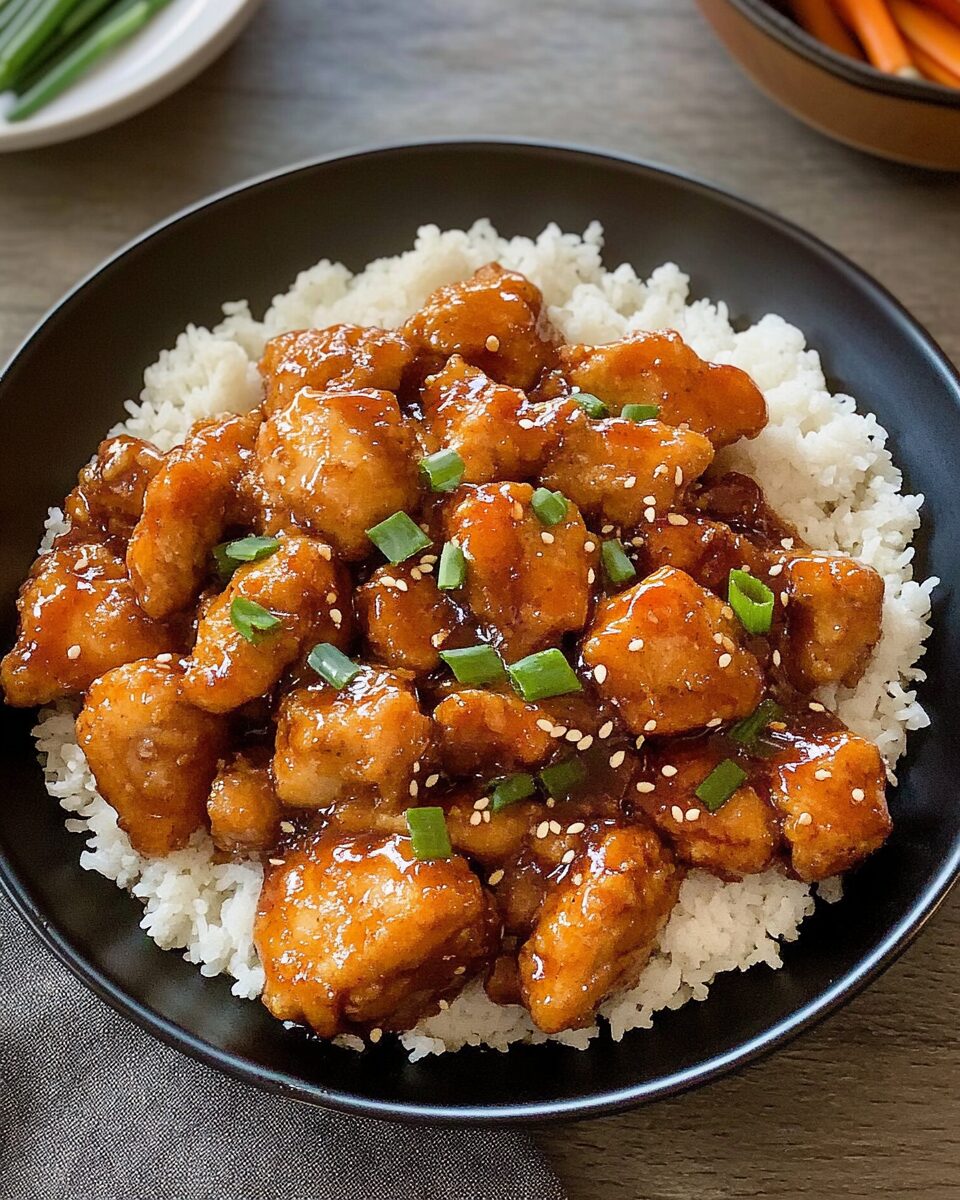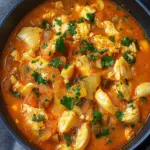The legendary General Tso’s Chicken is a beloved classic in Chinese-American cuisine, known for its crispy chicken pieces bathed in a glossy, bold sauce that perfectly balances sweet, savory, and spicy flavors. This homemade version delivers restaurant-quality taste without the extra grease or mystery ingredients. Perfect for weeknight dinners or impressive weekend feasts, this dish will have everyone asking for seconds. Whether served with steamed rice, stir-fried veggies, or enjoyed straight from the pan, this recipe is your go-to when takeout cravings hit but you want to keep it homemade and satisfying.
Full Recipe:
Ingredients:
-
2 lbs boneless chicken thighs, cut into 1-inch pieces
-
1/2 cup cornstarch
-
1/4 cup all-purpose flour
-
2 eggs, beaten
-
Vegetable oil, for frying
-
2 teaspoons garlic, minced
-
1 teaspoon fresh ginger, minced
-
1/4 teaspoon crushed red pepper flakes
-
1/4 cup soy sauce
-
3 tablespoons rice vinegar
-
3 tablespoons sugar
-
1 tablespoon hoisin sauce
-
1/2 cup water
-
1 tablespoon cornstarch (for slurry)
-
2 tablespoons water (for slurry)
-
Sliced green onions and sesame seeds, for garnish
Directions:
-
In a mixing bowl, combine cornstarch and flour. Dip chicken pieces into beaten eggs, then coat with the cornstarch-flour mixture.
-
Heat vegetable oil in a deep skillet or wok over medium-high heat. Fry the chicken in batches until golden and crispy. Remove and drain on paper towels.
-
In a separate pan or clean wok, add a small amount of oil and sauté garlic, ginger, and red pepper flakes for about 30 seconds.
-
Stir in soy sauce, vinegar, sugar, hoisin sauce, and water. Bring to a simmer.
-
Mix 1 tablespoon cornstarch with 2 tablespoons water to make a slurry. Slowly stir slurry into the simmering sauce and cook until it thickens.
-
Toss fried chicken into the sauce until evenly coated.
-
Garnish with sesame seeds and sliced green onions before serving.
Prep Time: 15 minutes | Cooking Time: 25 minutes | Total Time: 40 minutes
Kcal: 390 kcal | Servings: 4 servings
The Story Behind General Tso’s Chicken
General Tso’s Chicken is one of the most iconic dishes in Chinese-American cuisine. With its signature blend of sweet, savory, and spicy flavors, paired with crispy fried chicken, this dish is a staple in takeout culture across North America. Surprisingly, despite its popularity in Western countries, it’s not a dish that originates from traditional Chinese home kitchens. In fact, many people in China haven’t even heard of General Tso’s Chicken.
The dish is believed to be named after Zuo Zongtang (also known as General Tso), a 19th-century Chinese military leader from Hunan province. However, there’s no known connection between the general and the dish itself. The modern version we know today was first popularized in New York City in the 1970s by Chef Peng Chang-kuei, a Taiwanese chef who fled to the U.S. during the Chinese Civil War. Chef Peng claimed to have created the dish by blending the bold and spicy characteristics of Hunan cuisine with a sweeter, more approachable profile tailored to American palates.
Since then, General Tso’s Chicken has become a beloved favorite at countless Chinese-American restaurants and homes alike.
What Makes General Tso’s Chicken So Addictive?
General Tso’s Chicken is the perfect fusion of texture and taste. It’s a dish that hits every flavor note: salty, sweet, spicy, umami, and tangy. The magic lies in its multi-dimensional sauce, which includes soy sauce for saltiness, sugar for sweetness, vinegar for tang, garlic and ginger for pungency, and a touch of chili for heat. When this sauce clings to the crispy fried chicken pieces, it creates a flavor explosion in every bite.
What makes this dish especially irresistible is the contrast between the crunchy exterior of the chicken and the sticky, glossy sauce that envelops it. The balance of flavors and textures makes it a highly satisfying main course. Whether served with a bowl of steamed jasmine rice or stir-fried noodles, it’s a dish that elevates any dinner table.
Cultural Evolution: From Taiwan to Takeout Boxes
While Chef Peng Chang-kuei may have introduced General Tso’s Chicken to the U.S., it didn’t become a nationwide sensation overnight. The American palate of the 70s and 80s was only beginning to embrace international flavors, and General Tso’s sweet-spicy profile made it a hit. Unlike traditional Hunan dishes, which are generally spicier and less sweet, the Western version was toned down and sweetened up something that appealed to a wide audience.
By the 1990s, the dish had made its way into almost every Chinese takeout menu in the United States and Canada. It quickly became a default choice for many who wanted something familiar yet bold. This version of General Tso’s Chicken, often deep-fried and heavily sauced, became synonymous with comfort food in Chinese-American households.
As food culture evolved and people became more health-conscious, various renditions of the dish also emerged. You can now find baked versions, air-fried adaptations, and even vegetarian spins made with tofu or cauliflower all inspired by the flavor foundation that General Tso’s Chicken created.
Cooking Tips & Techniques for the Best General Tso’s Chicken
Mastering General Tso’s Chicken at home is all about technique and timing. While the ingredients are fairly accessible, nailing the perfect texture and flavor takes some finesse. Here are a few tips:
-
Use Boneless Thighs: Chicken thighs are preferred over breasts because they stay juicier and more flavorful after frying.
-
Double Fry for Extra Crunch: For restaurant-level crispiness, consider frying the chicken twice. The first fry cooks the meat, and the second crisps up the outer layer.
-
Prep the Sauce Separately: Cook the sauce in a separate pan to control thickness and prevent burning. Adding a slurry (cornstarch + water) allows you to fine-tune the consistency.
-
Toss, Don’t Soak: When combining the chicken with the sauce, quickly toss it just enough to coat. Avoid letting the chicken sit too long in the sauce, or it may lose its crunch.
-
Garnish with Fresh Ingredients: Green onions and sesame seeds not only add visual appeal but also provide a refreshing counterbalance to the rich sauce.
Pairing Suggestions
General Tso’s Chicken is versatile when it comes to sides and pairings. Traditionally served over white rice, the sauce soaks into the rice for a complementary experience. However, there are other great side options as well:
-
Steamed Jasmine or Basmati Rice: A neutral base that lets the chicken shine.
-
Fried Rice: Adds complexity and texture; great for soaking up any leftover sauce.
-
Stir-Fried Vegetables: Broccoli, bell peppers, snow peas, and bok choy balance the richness of the chicken.
-
Egg Rolls or Spring Rolls: Make it a full takeout-style meal.
-
Asian Slaw: Offers crunch and acidity to cut through the sweetness and oiliness of the dish.
Beverage-wise, an iced green tea or a light beer pairs well with General Tso’s, helping cleanse the palate between bites.
Nutrition Considerations
General Tso’s Chicken is undeniably indulgent. Because it is deep-fried and coated in a sugary sauce, it can be high in calories, fat, and sodium. However, you can control the nutritional content by making it at home:
-
Fry in healthier oils like avocado or peanut oil.
-
Use less sugar or substitute with honey or coconut sugar.
-
Go for a pan-seared or baked version to reduce oil use.
-
Increase the amount of vegetables in the meal.
By customizing the dish, you can maintain the flavor while adjusting it to better suit your dietary goals.
Why Make It at Home?
Restaurant versions of General Tso’s Chicken are often loaded with excess oil, MSG, and preservatives. Making it at home gives you complete control over the ingredients, portion size, and preparation methods.
It’s also a fun dish to prepare. From the sizzling sounds of frying to the rich aroma of garlic and ginger, cooking General Tso’s Chicken is an immersive and rewarding culinary experience. You can get the whole family involved in coating the chicken or stirring the sauce, turning it into a collaborative meal.
Moreover, the final result looks impressive glossy, colorful, and restaurant-worthy. Whether you’re entertaining guests or simply treating yourself to a flavorful dinner, homemade General Tso’s Chicken never disappoints.
Conclusion:
General Tso’s Chicken has earned its place as a modern culinary classic not because it’s deeply rooted in traditional Chinese cooking, but because it bridges cultures, generations, and tastes. It’s a dish that speaks to the power of culinary adaptation, bringing bold Asian flavors to everyday Western kitchens.
Whether you’re reminiscing about your favorite takeout meal or exploring international cuisine from home, this dish deserves a spot in your rotation. The combination of sweet, spicy, and savory elements makes it unforgettable, and the flexibility in preparation ensures it can suit almost any dietary preference.






